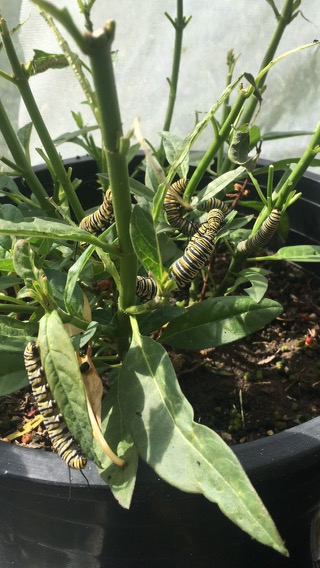 Friday, Sept. 8 Scott volunteers to take home the most recent chrysalid for release in his neighborhood.
Friday, Sept. 8 Scott volunteers to take home the most recent chrysalid for release in his neighborhood. Tuesday, August 29 of the vivarium six, 1 caterpillar (A) fatality (tachinid) today. The four remaining larvae are simultaneously briefly and unexpectedly pausing their feeding behavior (all are still). (B) missing one antennae is now 10:39 am) on the netted vivarium "ceiling". Is it ready for it's chrysalid stage? No. It has descended back to the wooden deck. 10:45 am now back to the ceiling. 10:50 now at leaf level. 10:53 now at bottom.
Monday, August 28, 2023 Monarch caterpillar census 10 (five on the deck, six in the vivarium). The 6th, too small to be noticed, maybe 1st or 2nd install, was a milkweed stowaway. Idea: this larva too young to be parasitized? Only 5 seeds sprouted from the 40 tropical milkweed seeds from 2021. From a late start*, caterpillar activity is back in full swing.
*Later start because of wet winter, and/or cooler temperature?
Tuesday July 25, 2023 A. I found a monarch caterpillar today on the soil near the base of a tropical milkweed on the front deck (south long planter.) B. Also, planted (in a 4"X10"tray) 40 seeds originally collected between November and December 2021. C. Milkweed trimmed down to 3inches on the south side of the house have not yet come back. 4 containers of tropical milkweed (on or adjacent to the deck) are growing fast.
Photo Paul Ho
Sunday, July 23 Paul has 20 monarch caterpillars in Zone 3. They are eating milkweed faster than the plants can grow.
See photo -->
How many caterpillars are in this photo?
Friday, June 23, 2023 5th straight day of sunshine. Paul (Zone 3 on the map) reports that his first monarch caterpillar has just gone to chrysalis stage. Let's check where he is on the map. I bet it's warmer in Zone 3.
Tom and Virginia(Zone 2) report they've spotted monarch adults in the last few weeks, but none seen here is South Laguna. Only 1 butterfly sighting (laying eggs) here in Zone 1 but I only found 1 egg.
Wednesday June 21 Third sunny day in a row following 9 weeks without sunshine here in Laguna Beach, which may explain why we haven't seen monarch butterflies as of this date.
Milkweed has sprouted from last seasons trimmed 3 inch stalks. (See Figure 1 below). So there is plenty of food when they arrive.
Almost Season 3.
Wednesday, Feb. 1, 2023 I have trimmed last season's tropical milkweed down to about 3 inches from the ground. This will reduce Monarch butterfly exposure to the fatal disease known as OE Ophryocystis elektroscirria (See Figure 2 below) Click HERE for more.
Spring temperatures are a few weeks away but good news has been published.(See Winter Count below)
WINTER COUNT SHOWS REBOUND FROM NEAR EXTINCTION
2020 Fewer than 2000 butterflies
2021 247,000.
2022 330,000
 FIGURE 1. If you haven't topped your tropical milkweed, this is a good time to do it to protect next seasons monarch butterflies from OE. Ophryocystis elektroscirria, a protozoan (single celled) organism infecting monarch, queen and lesser wanderer butterflies that scientists believe evolved alongside monarchs.
FIGURE 1. If you haven't topped your tropical milkweed, this is a good time to do it to protect next seasons monarch butterflies from OE. Ophryocystis elektroscirria, a protozoan (single celled) organism infecting monarch, queen and lesser wanderer butterflies that scientists believe evolved alongside monarchs.OE damage takes place during the chrysalid stage. While the infected adults do not survive to migrate, they do spread the protozoan parasite. If you see the sign of infection above, keep this butterfly isolated when it emerges, Place milkweed florets with blossoms to feed the isolated adult.
To control the dangerous spread of Ophryocystis elektroscirrha (OE), a parasite that infects monarch butterflies, I have cut my tropical milkweed plants down to 4 inch stems without leaves. (see photo below)







No comments:
Post a Comment